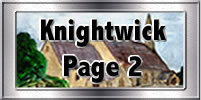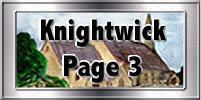Knightwick Index Page 1
I was born at Knightwick Post Office in October 1949, Dr. Clarke was then living at Woodford House and he was there at my birth. My parents were Ted and Doris Holland and they lived there with my sister Josephine, brother Graham and my mum's parents John and Lucy Jones. My Grandfather John Jones was the sub-postmaster, and after he retired my mother Doris Holland took over from him. Mum ran the Post office and it was also the local shop, selling all types of grocery along with cigarettes and also my favourites ice cream and all the many old bottles with all types of sweets in. My dad had a wonderful garden that sadly no longer exist in any shape or form, where he grew all the vegetables that we needed. He also kept hundreds of chickens for their eggs and also to sell on at market and also in our top orchard three pigs which were often having young ones which I loved to play with. The orchard had many Damson trees and we used to pick these when ripe and sell them on via Alec Brodie in Whitbourne for jam making and also for brewing beer. Dad also loved flowers and his garden would be awash with them, he loved Sweet Williams and had masses of them close to our lawn. Splitting the garden in two, through its length, were two lines of Raspberry bushes and these were picked and eaten in the summer with fresh cream.
The shop was used a lot by local villagers but its main profit came from traffic passing through on the A44, unfortunately this came to an end when due to many problems with the existing bridge over the river Teme between the Doctors at Woodford House and the Talbot Hotel at the bottom of the Ankerdine Hill, the council decided to build a new by-pass and bridge and demolish the old one and replace it with a foot bridge. The new Knightsford Bridge was opened in 1958 and then we no longer had the bulk of traffic passing by. So, slowly and eventually the shop part of the Post Office came to an end as it was no longer viable. Mum carried on with just the Post Office until her death in 1974, after a short time dad could no longer carry on with it and so the Post Office closed and was reopened in the old Nurses House above the Alms Houses.
Changes have certainly happened over the years in Knightwick and when I was young I always remember the AA box that stood at the end of a small coppice adjacent to the Talbot Hotel on the other side of the entrance to Ankerdine Farm, the man who used it used to ride a motorbike and sidecar. After this the coppice was chopped down and a new semi-detached house was built for the farm hands who worked for Henry Walker at Ankerdine Farm.
At the Post Office there had once been the Telegraph Office and with the telephone's arrival there was an exchange that was situated in our lounge behind the room which hosted the Post Office and shop. My mother used to be the operator of the exchange, but eventually a bigger and unmanned exchange was built just above Knightwick's church and even that was upgraded to a larger modern one which is situated behind the Old School. Interestingly the old Exchange became Knightwick's village hall and was often used for talks on different subjects; but after being sold it was converted into a house.
Next door to the Post Office was a little black and white cottage [Bridge Cottage] where the Morris family lived, this was knocked down and the building you see there today was built by Henry Walker for him and his wife to live in after their retirement.
Ted Morris who lived there moved to another black and white cottage [Church Cottage] which was opposite the church but eventually this cottage too was knocked down and on the grounds the two houses you see today were built.
The Alms houses and Nurses House situated above the Old School were originally built by the charities of John Francis Greswolde-Williams.
In 1890 John Francis Greswolde-Williams by deed founded six almshouses situated in the parish of Doddenham, four of the almshouses to be allotted to residents of Knightwick and Doddenham, or either of them, and two to residents in the chapelry of Lulsley. The same donor erected a residence for a nurse for poor sick persons resident in the same three parishes.
St. Mary's Church was built and consecrated in 1855, opening in 1856. The church is built with Ankerdine stone and faced with Bromyard Downs stone and cost £200 pounds. I was in the choir there when I was a boy, and myself and all the other children in the choir would always have a choir practice where Mary Walker's mother would play the organ and Mary would tutor us on our choir singing. Later after Mrs. Walker died Mary took over playing the organ for all the church services and when the church closed Mary carried on playing the organ for the congregation at the old Knightwick Chapel, close to where she lived at the Old Rectory. Sadly the church did close and today has become a family home.
In those day my favourite time of the year was the Harvest Festival, all the villagers would bring flowers and produce and decorate the church, I loved the different pungent and effusive smells of the different varieties of flowers and vegetables. A service would be held in the evening and after the service all the villagers would make their way down to the Hop Kilns at Ankerdine Farm where the Walkers would arrange a wonderful Goose supper as a finale to the thanks given for another years harvest.
Walkers were renowned for their Herefordshire cattle and this was David Walker's side of the business at the Manor, while Henry Walker had the Hop Yards, at Ankerdine Farm. Every year people from the Black Country would come down and work along side the locals to pick the hops and stay and live in the out buildings on the farm until the end of the hop picking. Eventually the task became mechanised and a Hop Picking Machine was installed on the farm and less people were needed. In the old days my mother would sit me at the end of one of the hop cribs while she and others picked the hops in to the crib. As I grew I eventually spent some time on the farm helping with the picking. Unfortunately some of the hopyards, the ones off the Lulsley road came down with Wilt and were all lost to the disease. Hops are still grown and some of the yards are still behind the Talbot Hotel.
One of my dad's duties was to once a week clean the phone kiosk which stood on the pavement adjacent to the garden of Alan Morris, the kiosk is now gone and a post box is situated by where it once stood.
The Talbot Hotel was where as I became an adult I would spend time playing darts and pool, I had great times there during the many changes as landlords came and went. Since those days it has become a much larger establishment and also brews it's own beer which can be found sold at many other places too. We always used to take bets which would get flooded first the Talbot or the Post Office.
Dr. Clarke who lived at Woodford House was mad on collecting moths and outside the surgery waiting room which had been added on to the side of the house he had a large light fitting where he captured his prey. Around the time I was born he went in to partnership with a young doctor, Tony Parsons, who later after Dr. Clarke retired bought Woodford House and had a new Surgery built on the house grounds. Tony over the years became a very close friend and it was a sad day for me when he died, we had many great experiences together and I will never forget him or them.
Dr. Parsons and his wife Mary had originally lived at Shortlands but when they left and moved to Woodford House a new family moved in and they were Mr. and Mrs. Harris. Very kindly as they had children of their own they decided to open a youth club for the youngsters in the village and Mr. & Mrs. Anthony who then owned the Old School gave them permission to hold the meetings there under their supervision. Eventually this all ended and some of us still wanted a youth club and so kindly Mary Walker allowed us to use the tin hut in the grounds of the Old Rectory and John Foot agreed to be our mentor and keep an eye on us all. John was a great chap and we had some great times there. When I think back it was a big thing for John to have taken on something like that and time consuming especially as he had a young family of his own.
Tuberculosis (TB) is caused by a bacterium called Mycobacterium tuberculosis, it was still rife with out any cure when I was born and a hospice the Sanatorium was built half way up the Ankerdine Hill. Luckily today we have vaccination against this deadly disease and so it was that the Sanitorium closed and was sold and today is a small housing estate exists there still called the Sunningdale Estate after the first owners.
On a happier note Knightwick along with all the other villages used to have a Church Fete each year and this was held in the Ham meadows across the river from the Post Office. There were lots of things to participate in, including bowling for a pig (yes a real pig!) and every one used to enjoy the day.
Today there is still a Butchers Shop at Knightwick and one has existed there all the years I have lived, my original memory is of the brothers George and Eric Stephenson and many a Saturday morning I had to queue there to buy our weeks joints and also bacon and sausages etc. Interestingly my grandfather John Jones was a pork butcher by trade but he changed his job to take on being the sub-postmaster at Knightwick. When he retired he moved with his second wife Mary to Haywood Cottage at the top of Ankerdine Hill, opposite the cottage is the walk way to the Ankerdine Knob where every one used to go for picnics. Also opposite as you start to ascend the walkway is a house called the Laurels and this was where my great grandparents Philip and Eliza Grubham lived.
Knightwick is still the beautiful village that it always was and once a month you can visit the Farmers Market and taste some of those wonderful foods and fresh produce from the gardens and animals kept by the sellers. Just like my father Ted Holland did at the Post Office all those years ago with out me realising how lucky we were.
Philip Holland

 ©peh
©peh





















































































































